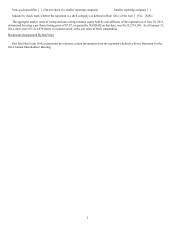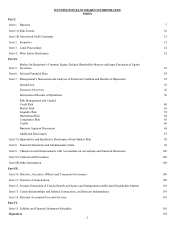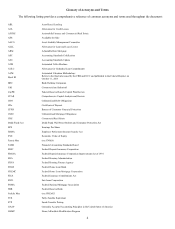Huntington National Bank 2013 Annual Report Download - page 18
Download and view the complete annual report
Please find page 18 of the 2013 Huntington National Bank annual report below. You can navigate through the pages in the report by either clicking on the pages listed below, or by using the keyword search tool below to find specific information within the annual report.12
entities with significant permitted trading operations will have to report certain quantitative information, beginning between June 30,
2014 and December 31, 2016, depending on the size of the banking entity’s trading assets and liabilities.
On January 14, 2014, the five federal agencies approved an interim final rule to permit banking entities to retain interests in
certain collateralized debt obligations backed primarily by trust preferred securities from the investment prohibitions of the Volcker
Rule. Under the interim final rule, the agencies permit the retention of an interest in or sponsorship of covered funds by banking
entities if certain qualifications are met. In addition, the agencies released a non-exclusive list of issuers that meet the requirements of
the interim final rule. At December 31, 2013, we had investments in ten different pools of trust preferred securities. Eight of our
pools are included in the list of non-exclusive issuers. We have analyzed the other two pools that were not included on the list and
believe that we will continue to be able to own these investments under the final Volcker Rule regulations.
The rules effecting debit card interchange fees under the Durbin Amendment, which became effective on October 1, 2011, have
negatively impacted our electronic banking income.
The Durbin Amendment, which was section 1075 of the Dodd-Frank Act, required the Federal Reserve to establish a cap on the
rate merchants pay banks for electronic clearing of debit transactions (i.e. the interchange rate). The Federal Reserve issued final
rules, effective October 1, 2011, for establishing standards, including a cap, for debit card interchange fees and prohibiting network
exclusivity arrangements and routing restrictions. The final rule established standards for assessing whether debit card interchange
fees received by debit card issuers were reasonable and proportional to the costs incurred by issuers for electronic debit transactions.
Under the final rule, the maximum permissible interchange fee that an issuer may receive for an electronic debit transaction is the sum
of 21 cents per transaction, a 1 cent fraud prevention adjustment, and 5 basis points multiplied by the value of the transaction. As a
result of implementing this lower debit card interchange fee structure, our electronic banking income was negatively impacted by over
$55 million in 2012 when compared to 2011.
On July 31, 2013, the Federal District Court in the District of Columbia issued a ruling in a lawsuit filed by a merchant group
challenging the validity of the Federal Reserve’s final rule under the Durbin Amendment. The Court ruling vacated the provisions of
the Federal Reserve’s final rule relating to standards for debit card interchange fees and the provision dealing with network non-
exclusivity, but stayed its action until further briefing on issues identified by the Court. Eventually, the District Court’s Ruling was
appealed to the Federal Circuit Court of Appeals for the District of Columbia, where the case is currently pending. If the Court of
Appeals rules in favor of the merchants, the Federal Reserve will likely be required to provide even more stringent caps on debit
interchange fees, which could adversely impact all banks that issue debit cards, including us, and which could result in an industry-
wide retraction of debit card products and replacement with other card products not subject to the Durbin Amendment. The Federal
Reserve and a banking trade organization are submitting briefs arguing that the Court of Appeals should overrule the District Court
and uphold the Federal Reserve’s final rule under the Durbin Amendment. Oral argument before the Court of Appeals was held on
January 17, 2014, and an expedited ruling is anticipated.
There are restrictions on our ability to pay dividends.
Dividends from the Bank to the parent company are the primary source of funds for payment of dividends to our shareholders.
However, there are statutory limits on the amount of dividends that the Bank can pay to the holding company. Regulatory approval is
required prior to the declaration of any dividends in an amount greater than its undivided profits or if the total of all dividends declared
in a calendar year would exceed the total of its net income for the year combined with its retained net income for the two preceding
years, less any required transfers to surplus or common stock. As a result of the deficit position of its undivided profits, prior to
December 31, 2013, the Bank could not have declared and paid any cash dividends to the parent company without regulatory
approval.
Since the first quarter of 2008, the Bank has made a capital reduction each quarter to enable payment of periodic dividends to
shareholders outside the Bank’s consolidated group on preferred and common stock of its REIT and capital financing subsidiaries.
We anticipate that those subsidiaries, and the Bank will be able to resume normal dividend payments during the first half of 2014.
If, in the opinion of the applicable regulatory authority, a bank under its jurisdiction is engaged in, or is about to engage in, an
unsafe or unsound practice, such authority may require, after notice and hearing, that such bank cease and desist from such practice.
Depending on the financial condition of the Bank, the applicable regulatory authority might deem us to be engaged in an unsafe or
unsound practice if the Bank were to pay dividends. The Federal Reserve and the OCC have issued policy statements that provide that
insured banks and bank holding companies should generally only pay dividends out of current operating earnings. Additionally, the
Federal Reserve may prohibit bank holding companies from making any capital distributions, including payment of preferred and
common dividends, if the Federal Reserve objects to the annual capital plan.
























